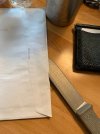tinfoil hat timmy
Gold Member
- Joined
- Aug 21, 2014
- Messages
- 21,030
I  ❤
❤ THIS
THIS
The BladeForums.com 2024 Traditional Knife is available! Price is $250 ea (shipped within CONUS).
Order here: https://www.bladeforums.com/help/2024-traditional/
Hey if you can’t get the bend out I’d be willing to give it a try, just drop me a note. I’ll pay shipping.Hard to resist. That P aint BS’inBehemoth is probably my favorite knife, such a monster. Really wanna swing a Light Chopper,,,bad. Cheers
View attachment 1943233
Until Nathan posted the video of him bending a K18 90-degrees, and it returning to true, I had NO idea the K18, (and in fact, D3V) could do that.Hard to resist. That P aint BS’inBehemoth is probably my favorite knife, such a monster. Really wanna swing a Light Chopper,,,bad. Cheers
View attachment 1943233
very interdastingUntil Nathan posted the video of him bending a K18 90-degrees, and it returning to true, I had NO idea the K18, (and in fact, D3V) could do that.
I believe I posted about medieval swords. The folks who study them, have done things like hardness test a whole lot of them, testing the edge hardness every 3cm (5cm?) down the edge, and found that
1) medieval heat treatments weren't particularly consistent (to be expected, with coal forges) and edge hardness in the same sword would vary on different sections of the edge
2) in general, hardnesses for swords varies between the mid-40s to mid-50s HRc, with hardnesses in the high-50s HRc being less common with European swords.
3) with the differential hardening in Japanese katana and tachi, the highest recorded/tested edge hardness was 61 (maybe 62?).
The softer hardness European swords could flex quite a bit and still return to true. While Japanese swords could flex a tiny bit, flexing/bending them more than a little bit would result in permanent bends (which I've also previously mentioned seeing happen with a single botched cut on rolled tatami, made with a $$$$$ authentic Japanese katana).
D3V is 61.5 HRc IIRC, which is as hard or harder than any historical swords. That it can flex 90 degrees and return to true, is mindblowing (and makes me even more excited about the K20).
Dude, you scuffed it!Hard to resist. That P aint BS’inBehemoth is probably my favorite knife, such a monster. Really wanna swing a Light Chopper,,,bad. Cheers
View attachment 1943233
Yeah. If that’s what pineapples look like in Hawaii then my grocery store has been selling me bunk product.Funny lookin pineapples

Yeah, that's just nuts, man.Yeah. If that’s what pineapples look like in Hawaii then my grocery store has been selling me bunk product.
Awesome pics. Which mountains were you in ?
A glorious place. Every time work or play takes me away from the city, I am a more content man. You must be, as well. Thank you for posting “the escape” for all of us!Not “real” mountains but in the east Cariboo BC

Stab it!! Stab it in its fruity little green eye!!!
